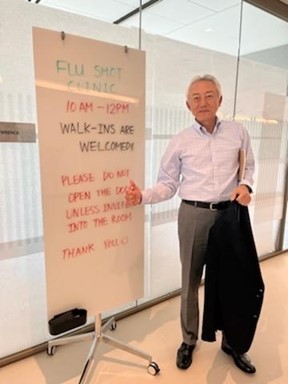Learn more about Mitsubishi International Corporation's efforts to improve employee health and well-being through innovative, personalized programs and initiatives.

For Mitsubishi International Corporation, employee health and well-being are strategic priorities. Mitsubishi International Corporation is a wholly-owned subsidiary of Mitsubishi Corporation (Americas), the holding company for Mitsubishi Corporation’s North America network. There over 20 affiliated companies in the U.S. participate in the same well-being program – approximately 1,300 employees. Frances Shields Dedeian is the organization’s general manager of human resources administration. She oversees the organization’s benefits, well-being, and engagement programs and initiatives.
The company first launched its employee wellness program in 2015, when the organization learned that employees were not getting preventive care exams. “We started seeing our loss ratio going up and our claims were getting higher,” Shields Dedeian said in an exclusive interview with the Cigna Healthcare Newsroom team. “Our costs were getting higher, and so we knew that we needed to start thinking more strategically about getting our workforce to get the care they need. From an executive support standpoint, it wasn’t a hard sell.”
Over the years, the program has changed and evolved dramatically – and employee health and well-being remains top of mind for leaders throughout the organization. “We truly believe that each and every one of us are on the hook for fostering a culture of health and well-being,” Shields Dedeian said. Mitsubishi International Corporation’s employee health and wellness strategy is built around the eight dimensions of health: financial, physical, emotional, social, intellectual, environmental, spiritual, and occupational.
Shifting to a hybrid model
Like many organizations, Mitsubishi International Corporation is rethinking its well-being strategy post-COVID-19. During the pandemic, organizations went virtual with their programming, but the move to hybrid work – where on any given day, employees are working from home and on-site – makes a hybrid mindset paramount.
“For in-person events, we make sure that our work-from-home colleagues have access to live streaming, and for virtual events, our offices are equipped to bring coworkers together to participate as a group,” Shields Dedeian said.
For example, the company hosted a hands-on herb gardening class virtually. The class was part of an emphasis on environmental sustainability this past April, and employees could sign up in advance and indicate whether they wanted to participate from their homes or an office. Mitsubishi International Corporation mailed gardening tools and other materials to work-from-home employees so that they could watch online and follow along. It also set up space in the office where on-site workers could come together and watch the course while creating their gardens together. “This was a truly hybrid event, and we got a lot of really good feedback on it from the people who participated,” she said.
Improving engagement through incentives and employee feedback

A points program is core to Mitsubishi International Corporation’s health and well-being strategy. Employees are encouraged to participate in healthy behaviors such as getting an annual check-up, participating in on-site programs and education, and receiving vaccines, and they receive points for logging these behaviors. Employees who reach 200 points are provided with a free month of health care coverage – a worthwhile incentive to garner participation. (Pictured left, Mitsubishi International Corporation employees participate in an on-site Flu shot clinic.)
Shields Dedeian is particularly proud of the way in which Mitsubishi International Corporation uses employee feedback to optimize and improve the health and wellness program. The team surveys employees at the conclusion of programs and initiatives, and conducts an annual employee survey in which health and well-being are key topics.
An inclusive approach to health and well-being
Part of the wellness strategy at Mitsubishi International Corporation is tying health and well-being to diversity, equity, and inclusion. This means creating personalized health and well-being programming with a keen focus on disease states and health outcomes trending among a specific cohort.
“We have thought a lot about how we can educate and influence different groups and demographics,” Shields Dedeian said. Mitsubishi International Corporation frequently ties this specialized content to annual observations, such as Black History Month in February or Women’s History Month in March. When celebrating a certain culture, programming may include a pop-up lunch, webinars, and other interactive experiences meant to educate and promote health and vitality among a specific slice of the workforce.
Mitsubishi International Corporation is unique in that 25% of its U.S. employees are Japanese expatriates. The organization has worked to refine its well-being strategy to ensure that it is inclusive of this group. For example, the company partnered with Cigna Healthcare to translate key health benefit materials and well-being programming into Japanese. Using video as a primary means of communication, the content is meant to educate these expatriates on how to use the benefits program.
How Cigna Healthcare helps Mitsubishi International Corporation engage employees around their health and well-being
Susan Ferrara is a senior health engagement consultant at Cigna Healthcare, whose primary responsibility is working with Mitsubishi International Corporation to help the company continuously evolve and improve their employee health and wellness strategy and programming. According to Shields Dedeian, Ferrara has become an extension of the Mitsubishi International Corporation team.
“Susan works with us in managing our well-being program day-to-day,” she said. “She’s committed and creative in thinking about all the different ways we can empower our workforce to prioritize their health and well-being.”
In addition, she noted Ferrara’s efforts to help Mitsubishi International Corporation optimize its well-being program – helping the team to understand which channels are most effective for specific programs and demographics. In the more than eight years since the launch of the health and wellness program at Mitsubishi International Corporation, the team has celebrated many successes.
“What I’ve learned is that a truly holistic wellness program has to be consistent,” Shields Dedeian said. “Communications and programming can’t just happen from time to time. Your health and well-being strategy must be embedded into everything you do as an organization. We’ve also seen a great deal of value from branding our well-being program. Measuring participation is important, as is celebrating the small successes along with the big ones.”

Wellness, mental health, and behavioral programs
Cigna Healthcare wellness programs and behavioral health services can help your employees thrive.